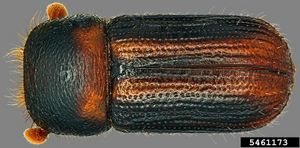Trypodendron (genus)
| Literature database |
|---|
| 54 articles sorted by: |
| • year (recent ones first) |
| • research topics |
| • countries/regions |
| • host plants |

Author(s): Steven Valley, Oregon Department of Agriculture
Source: IPM Images
Trypodendron Stephens, 1830
This genus is widely distributed in temperate regions of Europe, North America and Asia and contains more than 30 species of ambrosia beetles. They infest freshly felled as well as standing trees. In the latter case, mainly stressed and dying trees are attacked. However, there are also reports of attacks on apparently healthy trees. Mass-attacks are triggered by an aggregation pheromone.
Several species are regarded as pests of forest trees like the striped ambrosia beetle, Trypodendron lineatum, or the European hardwood ambrosia beetle, Trypodendron domesticum. The attacks will decrease the value of the timber. Significant economic losses have been, for example, reported from conifer trees in Alaska. On the other side, they are sometimes regarded as useful in decomposing stressed, damaged, and dying trees.
The larvae feed on fungi (mainly from the genus Ophiostoma), introduced by the adults into the infested tree. These fungi cause blue stain in the wood. The adults are small, about 4 mm long and dark brown, often with lighter patches or stripes on the elytra and pronotum. The genus can be recognized by the completely divided eyes and the morphology of the antennae.
Currently, the following species have been entered into the system: